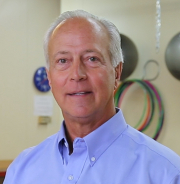Many golfers suffer from shoulder pain. Although shoulder pain is more frequently seen in amateur golfers it is one of the more common injuries on PGA and Champions Tour golfers. Often the shoulder itself is the primary problem however deficiencies in strength or mobility in other areas of the body can be the primary cause. Attention must be paid to the cervical spine, upper extremities, mid back, lower back, and lower extremities and how they may effect the shoulder. Dysfunction in any of these areas can force the shoulder to take on more physical stress that it is capable of handling. Under normal circumstances the shoulder has a significant responsibility in the performance of the golf swing. Force it to compensate for dysfunction elsewhere in the body and breakdown is likely.
When the shoulder itself is the primary cause there is one common denominator that must be addressed - shoulder alignment. Shoulder injury, poor posture, and work demands will directly effect shoulder alignment. Acute injury and repetitive stress will effect shoulder position. Poor shoulder position will increase the chance of injury. Therefore, shoulder position or alignment is a very basic yet extremely significant concept that must be improved upon to enhance golf performance.
What causes poor shoulder alignment and position? Most all daily activities and exercise programs are front dominant. They foster tightness and over- development of muscles in the chest and shoulder areas. Chronic stooped positions over a computer additionally promote connective tissue (ligaments and joint capsule) restriction and adhesions to develop. With time posture gradually changes and you find your shoulders rolled forward. You walk with your arms swinging across your body instead of in front of your shoulders. You stand with your hands rolled in and feel you are standing upright. The more soft tissues in the front of your torso tighten the weaker the muscles in the upper and mid back weaken. If not addressed the process continues and gets chalked up as a result of aging. Not necessarily so!
Important muscles that get tight in the body are the pectoralis major and minor, anterior deltoid, scalenes, subscapularis, teres major, and latissimus dorsi. Flexibility of these muscles must improve. Major muscles that weaken in the posterior aspect of the body are the mid and lower trapezius, rhomboids, levator scapula, posterior deltoid. The strength of these muscles must be reestablished. Exercise on a regular basis to address these imbalances must be performed. A few exercises to improve shoulder function are shown on this website under exercise protocol. Advanced soft tissue therapy for connective tissue and joint mobilization will complement a comprehensive approach to correcting the problem.
Therefore when handling shoulder pain from rotator cuff, labral, or muscle-tendon pathology shoulder alignment must be addressed. The more you can improve shoulder alignment the more successful you will be at eliminating shoulder pain. Your work with your PGA instructor will be more productive and ultimately your performance will improve!

